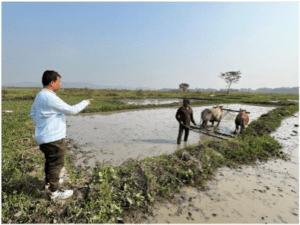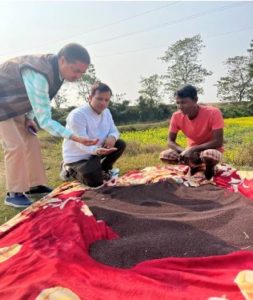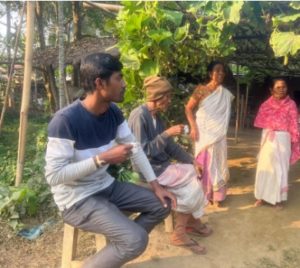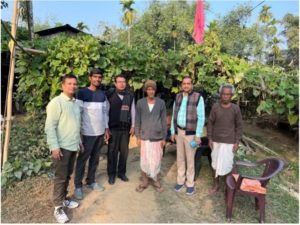

Exploring diversified livelihoods in rural India
November 2, 2023
The Crawford Fund’s highly sought after Student Awards are one way we support and encourage the next generation of Australians into study, careers and volunteering in international agricultural research. The next round of awards will open later this month!
With the resumption of global travel, many NextGen Student Awardees are back travelling overseas to undertake projects, with quite a few involved in our Instagram campaign, reporting when they are on the ground.
Bimal Sharma, a PhD student from the University of Canberra, visited India for his research project exploring rural community livelihoods and local knowledge on landscapes in the Brahmaputra Valley of the Assam Plain in India. He shares his experience below.
_______________________________________________________________________________________
“My visit to the Brahmaputra Valley of Assam Plain of India was successful post COVID-19 and flood impacts. I travelled around the agroecological zones of the Brahmaputra Valley, listened to the community, shared knowledge, learning about the culture, traditions and diversified livelihood patterns. It was a fantastic experience making real-world contact,” said Bimal.




Discussing the role of Self-Help Groups and women’ participation (left) and Bimal with other survey participants (right).
Bimal’s research project aimed to address three questions:
- What is the impact of seed fertiliser technology and climate variability on agriculture dependent livelihoods in the Brahmaputra Valley?
- What dynamic livelihood patterns are at work in the study area?
- Does the application of Socio-Ecological Production Landscapes (SEPLs) provide a more holistic picture of community livelihood?
Data was collected from household surveys and focus group discussions in each of the three agro-ecological zones – Lower, Middle and Upper Brahmaputra.
Bimal found that the increasing use of chemical fertiliser has had a direct impact on the changing agricultural productivity patterns of the valley, with the impacts most notable in the semi-humid areas of the valley. The expansion of cultivated land under high yielding varieties increased the productivity marginally in the most humid parts of the lower, as well as up to some extent in the central areas, of the valley.
“Variable rainfall in the crop system of the valley poses a fundamental challenge to the formation of different soil ecology by flooding and soil movement. The valley experiences severe flooding during the monsoon and post monsoon season and as a result crop damage and land degradation occurs. Acres of land have been abandoned due to the loss of soil quality,” he explained.
In relation to the second focus of his research, Bimal found that because of the number of people and cultures, the livelihood patterns are diverse. Up to 60-70 per cent of rural people depend on agriculture as a primary livelihood in the Brahmaputra Valley. Rice is the principal crop, followed by rape and mustard, maize, wheat, sugarcane, black lentil, jute, and potatoes.
Assamese community practice traditional cultivation but, in some cases, agricultural machinery is used. As the monsoon often destroys crops because of flooding, winter crops are much safer than summer crops, and irrigation is used during the autumn season.
Assamese farmers also grow vegetables for both self-consumption and commercial purposes, and the market accessibility for vegetable sales is well-connected. Locally produced vegetables are getting more attention from customers due to the low fertiliser used.
As an alternative to agriculture or to supplement their incomes, some Assamese depend on traditional arts and crafts.
Bimal observed that young generations are interested in mushroom cultivation, piggery, beekeeping, and poultry farming. Some of those surveyed took a loan from a bank and invested in farming. They are happy with the established business from which they earn reasonable income.
“The rural population also depends on the wetland for their livelihood in the Brahmaputra Valley. Fish from wetlands are considered the best quality fish and have market demand. The government has imposed restrictions on fishing from the wetlands, which is a concern for those who depend on the wetlands for their livelihood.”
Bimal also noted that there are several Self-Help Groups (SHGs) in the Brahmaputra Valley working across areas including weaving, pig and poultry farming, artisan work, and business skills. There is strong participation of women in the SHGs, which encourages female entrepreneurship and provides economic support.
“I used the methodological approach of Socio-Ecological Production Landscapes (SEPLs) to assess more holistically community livelihoods in relation to the natural resource value-based knowledge of the rural dwellers in the Brahmaputra Valley,” said Bimal.
SEPLS are defined as dynamic mosaic landscapes and seascapes with habitats and land uses including villages, farmland and adjacent woods, forests, grasslands, wetlands and coastal areas. A set of indicators was developed to provide a tool for communities to understand their resilience and encourage the practices that strengthen it.
Bimal found that the three main challenges facing the rural communities in the Brahmaputra Valley were:
- Flash floods, poor drainage systems (especially on farm roads) and water management resulting in loss of limited and valuable paddy fields.
- Frequent river erosion and landslides causing huge loss of fertile soils, agriculture land, animal and property loss.
- Wetland degradation due to human horizontal expansion for settlement.
“The farmers in the Brahmaputra Valley believe that their activities are having a worse impact than climate change in the valley, and that education for farmers is essential to understand the use of new varieties, fertilisers, insecticides, pesticides and land management to help build more resilience into the system,” concluded Bimal.




